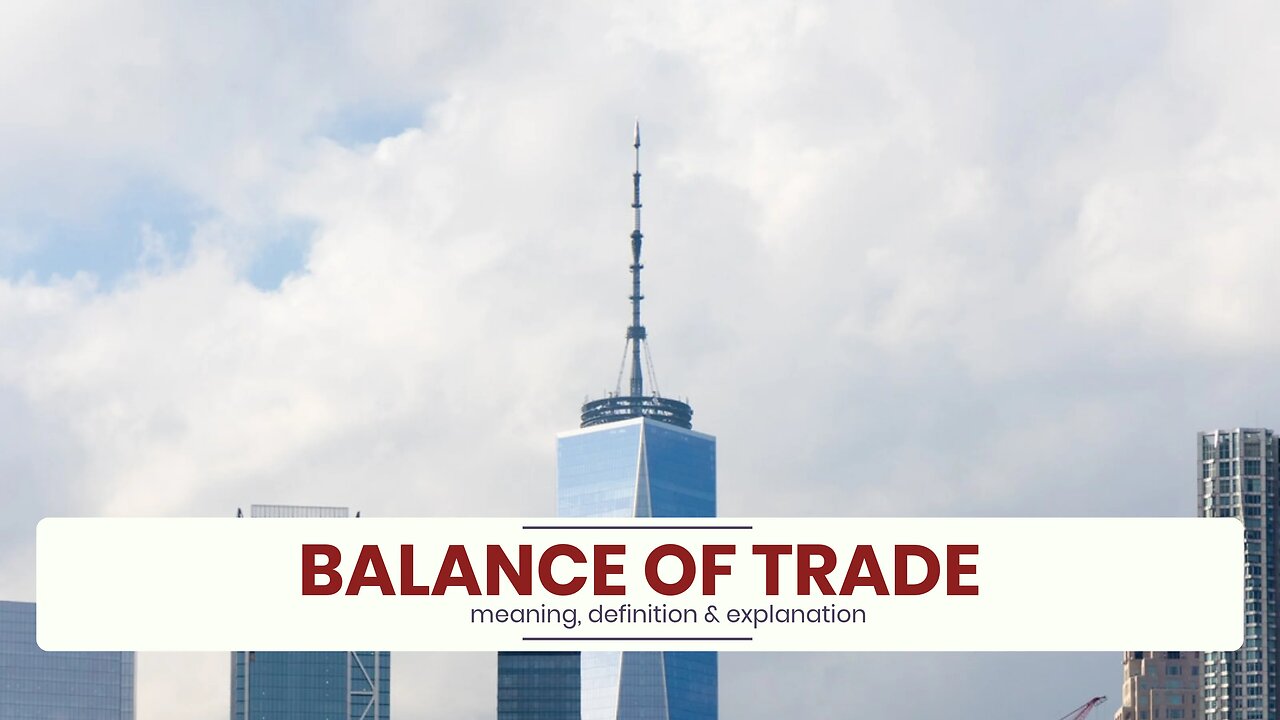Premium Only Content

What is BALANCE OF TRADE?
✪✪✪✪✪
http://www.theaudiopedia.com
✪✪✪✪✪
What does BALANCE OF TRADE mean? BALANCE OF TRADE meaning - BALANCE OF TRADE definition - BALANCE OF TRADE explanation. What is the meaning of BALANCE OF TRADE? What is the definition of BALANCE OF TRADE? What does BALANCE OF TRADE stand for? What is BALANCE OF TRADE meaning? What is BALANCE OF TRADE definition?
The commercial balance or net exports (sometimes symbolized as NX), is the difference between the monetary value of a nation's exports and imports over a certain period.
If a country exports a greater value than it imports, it is called a trade surplus, positive balance, or a "favourable balance", and conversely, if a country imports a greater value than it exports, it is called a trade deficit, negative balance, "unfavorable balance", or, informally, a "trade gap".
Sometimes a distinction is made between a balance of trade for goods vs one for services.
The balance of trade forms part of the current account, which includes other transactions such as income from the net international investment position as well as international aid. If the current account is in surplus, the country's net international asset position increases correspondingly. Equally, a deficit decreases the net international asset position.
The trade balance is identical to the difference between a country's output and its domestic demand (the difference between what goods a country produces and how many goods it buys from abroad; this does not include money re-spent on foreign stock, nor does it factor in the concept of importing goods to produce for the domestic market).
Measuring the balance of trade can be problematic because of problems with recording and collecting data. As an illustration of this problem, when official data for all the world's countries are added up, exports exceed imports by almost 1%; it appears the world is running a positive balance of trade with itself. This cannot be true, because all transactions involve an equal credit or debit in the account of each nation. The discrepancy is widely believed to be explained by transactions intended to launder money or evade taxes, smuggling and other visibility problems. Especially for developing countries, the transaction statistics are likely to be inaccurate.
Factors that can affect the balance of trade include:
1. The cost of production (land, labor, capital, taxes, incentives, etc.) in the exporting economy vis-a-vis those in the importing economy;
2. The cost and availability of raw materials, intermediate goods and other inputs;
3. Exchange rate movements;
4. Multilateral, bilateral and unilateral taxes or restrictions on trade;
5. Non-tariff barriers such as environmental, health or safety standards;
6. The availability of adequate foreign exchange with which to pay for imports; and
7. Prices of goods manufactured at home (influenced by the responsiveness of supply)
In addition, the trade balance is likely to differ across the business cycle. In export-led growth (such as oil and early industrial goods), the balance of trade will shift towards exports during an economic expansion. However, with domestic demand led growth (as in the United States and Australia) the trade balance will shift towards imports at the same stage in the business cycle.
Monetary balance of trade is different from physical balance of trade (which is expressed in amount of raw materials, known also as Total Material Consumption). Developed countries usually import a lot of raw materials from developing countries. Typically, these imported materials are transformed into finished products, and might be exported after adding value. Financial trade balance statistics conceal material flow. Most developed countries have a large physical trade deficit, because they have a large ecological footprint. Many civil society organisations claim this imbalance is predatory and campaign for ecological debt repayment.
-
 1:52
1:52
The Audiopedia
10 months agoWhat is EXECUTIVE DIRECTOR?
531 -
 UPCOMING
UPCOMING
Badlands Media
7 hours agoBaseless Conspiracies Ep. 131
5.26K3 -
 36:21
36:21
The Why Files
10 hours agoMysteries of the Sea Vol 2: Ghost Ships & Unexplained Maritime Disappearances
5.04K7 -
 LIVE
LIVE
TimcastIRL
2 hours agoTrump CRUSHING Democrats, New Polls Show Democrats SINKING, GOP AHEAD Despite SMEARS | Timcast IRL
12,594 watching -
 9:30:09
9:30:09
Dr Disrespect
10 hours ago🔴LIVE - DR DISRESPECT - TARKOV ALL DAY
158K16 -
 LIVE
LIVE
Akademiks
4 hours agoDay 1/30. Diddy TRIAL Starts today! Brittany Renner marries Kevin Gates? Future Beefin w/ TRIPPIE?
2,364 watching -
 LIVE
LIVE
Page Six
8 hours agoMet Gala 2025 red carpet arrivals | Watch live
659 watching -
 LIVE
LIVE
SpartakusLIVE
4 hours agoDuos w/ Twitty || CHAMPION of Verdansk brings you Monday MOTIVATION
258 watching -
 LIVE
LIVE
SilverFox
54 minutes ago🔴LIVE - OBLIVION REMASTERD - MAIN QUEST
79 watching -
 1:27:44
1:27:44
Glenn Greenwald
4 hours agoNIH Ends Fauci's Brutal Dog Experiments; MTG and Massie Shut Down Law to Criminalize Israel Boycotts | SYSTEM UPDATE #449
71.6K76